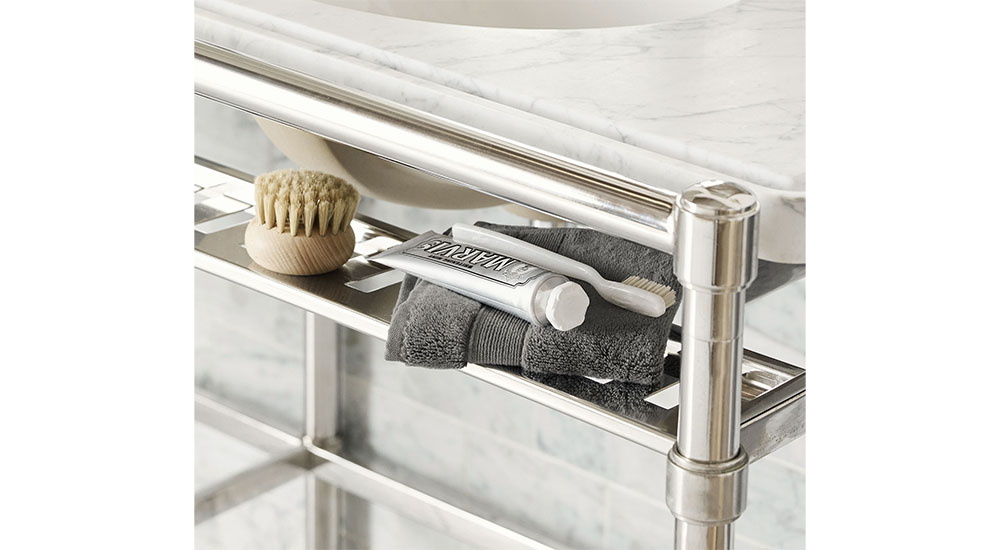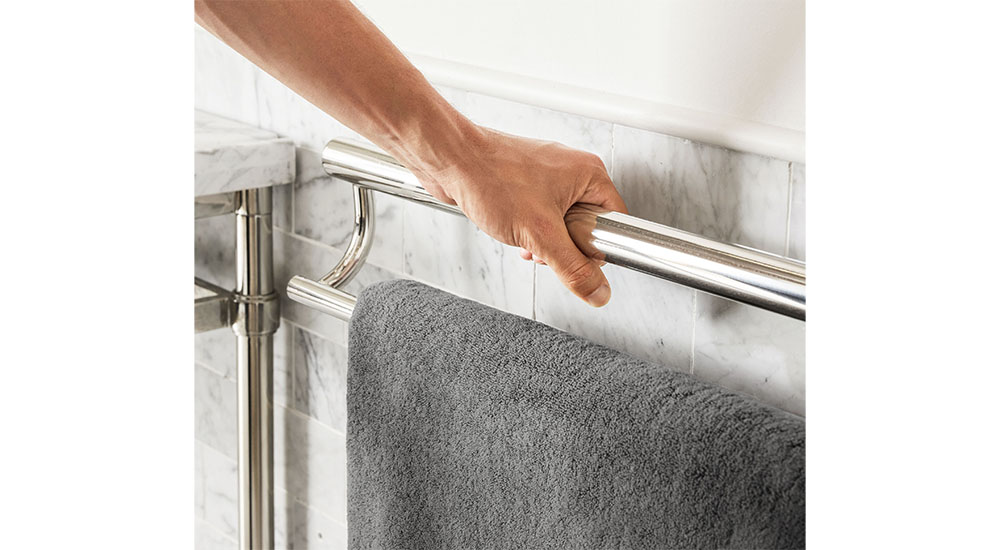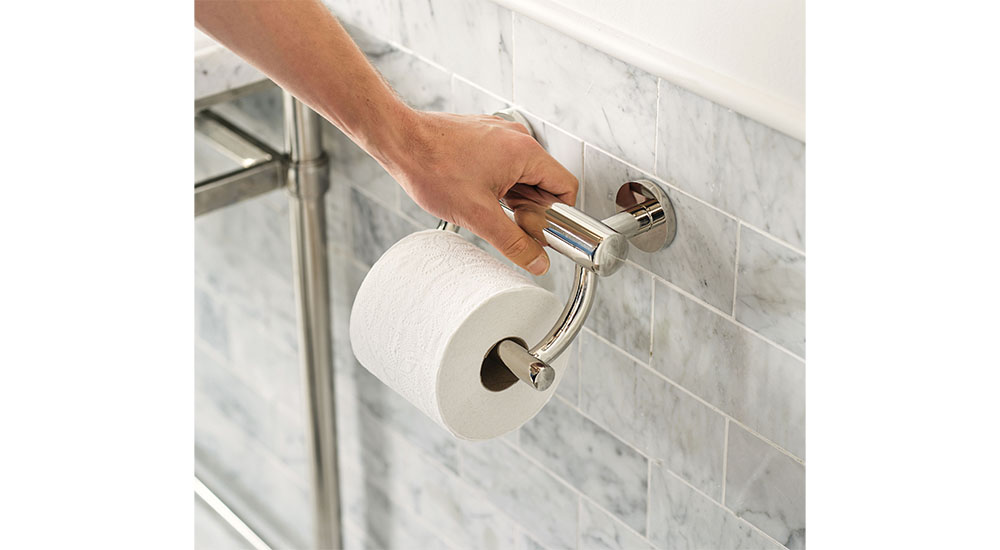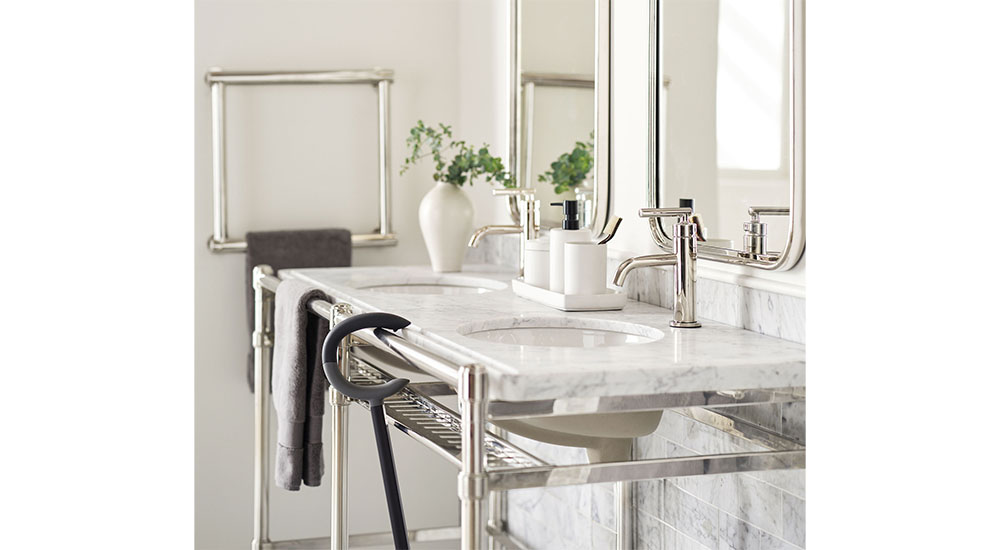When Michael Graves Design and Pottery Barn came together to create a new accessible bathroom collection, the ambition was larger than a product launch. This collaboration signaled a cultural shift, moving home healthcare design from the margins into the mainstream and showing that safety and style can be natural partners.
Above: The Everson Metal Double Sink Vanity designed by Michael Graves Design for Pottery Barn incorporates grab bars. Photo: Pottery Barn
Reframing Home Healthcare

The vanity, with its subtle integrated support elements and within-reach storage, demonstrates that function and aesthetics can coexist seamlessly. Photo: Pottery Barn
The project was guided by a shared belief: the bathroom should not force people to choose between safety and beauty. According to the Centers for Disease Control and Prevention, nearly 234,000 bathroom-related injuries occur in the United States each year, with almost 80% caused by falls. Yet the design marketplace has long offered only two extremes: decorative fixtures without safety consideration or stigmatizing, clinical-looking products borrowed from institutional healthcare.
Michael Graves Design and Pottery Barn set out to challenge this false choice. The goals were threefold:
• Destigmatize assistive care by designing products as lifestyle accessories, not medical equipment.
• Seamlessly merge safety and style, ensuring ADA-level features disappear into timeless design language.
• Design for every body, serving a broad audience that includes older adults aging in place, people living with temporary or permanent disabilities, multigenerational households and families planning for the future.
This vision required elevating accessibility from an afterthought to a form of design foresight – solutions that adapt gracefully to evolving household needs without costly renovations or compromise.
From Hospital to Home

Grab bars that double as towel bars provide discreet stability. Photo: Pottery Barn
Michael Graves Design’s credibility in this space stems from decades of work at the intersection of design and healthcare. The team has conducted extensive ethnographic research in hospitals across North America and Europe, studying patients, caregivers and administrators in their daily routines. Observing and listening closely to those most affected has revealed insights that transcended age or diagnosis. Independence, dignity, ease and reassurance emerged as universal needs.
Applying these lessons to the home meant recognizing that the same approaches and principles guiding hospital innovation – systems thinking, empathy and inclusivity, could inform residential spaces as well. The team’s approach has always been rooted in the philosophy of design with, not design for. This ensures that the voices of older adults, caregivers and individuals with disabilities shape the design criteria from the beginning, resulting in products that resonate emotionally while performing functionally.
A Retailer’s Role
If Michael Graves Design brought healthcare informed design methodology and consumer insights, Pottery Barn contributed deep expertise in residential living, consumer expectations and market reach.
That expertise shaped the collaboration in two ways. First, it ensured the collection was rooted in emotional connection as well as functional innovation. Bathrooms are not only sites of risk, they’re personal spaces where families begin and end their days, where children learn independence and where older adults maintain autonomy. The retailer’s sensibility brought warmth and familiarity, ensuring the collection felt at home in both traditional and modern interiors.
Second, the store’s broad consumer reach helped normalize accessibility as part of mainstream design. Rather than relegating safety features to specialized catalogs or medical suppliers, the collaboration placed them in the same retail environment as other home products. This reframed the conversation. Accessible design is not about compromise; it is about enhancing everyday living for every body.
Inclusive Healthcare Design

A grab bar caps the Linden toilet paper holder, offering a handhold where it’s needed. Photo: Pottery Barn
The bathroom collection reflects a shift both partners hope to accelerate. For decades, accessibility was seen as an afterthought, added when needed and often carrying the stigma of hospitals and institutions. This collaboration reframes it as a fundamental principle of good design, the idea that a well-conceived home is one that accommodates life’s transitions without sacrificing visual harmony.
The challenges of accessibility in product development remain real. Shifting perception, embedding functionality without visible compromise, and anticipating diverse household needs are not simple tasks. Yet the rewards are transformative. A toilet paper holder with an integrated grab bar provides peace of mind to an older adult, support to a teenager recovering from injury and balance to a child learning independence. A vanity can be a statement of refinement while offering stability and reach to those who need it most.
Ultimately, the collaboration between Michael Graves Design and Pottery Barn demonstrates the potential of design to not only prevent accidents and reduce risk but also enrich the emotional and aesthetic quality of everyday life. It is an invitation to imagine a future where every household, regardless of age or ability, is supported by design that is as empathetic as it is elegant.
—Donald Strum, President, Michael Graves Design









